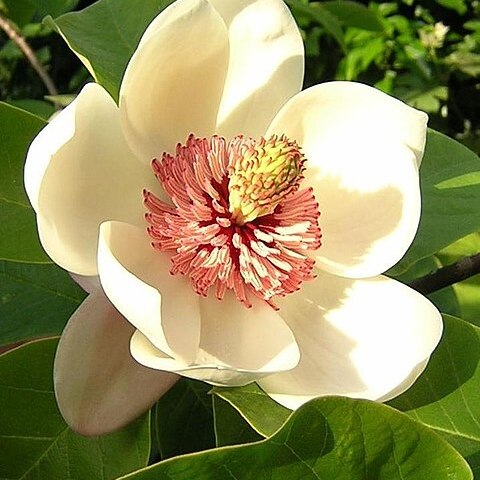Trees or shrubs, evergreen. Bark usually gray and smooth or sometimes coarsely deeply furrowed. Twigs with annular stipular scar. Stipules membranous, free or adnate to petiole and leaving a stipular scar on petiole. Leaves spirally arranged, folded in bud, erect when young; leaf blade thickly papery or leathery, margin entire. Flowers terminal on terminal brachyblasts, solitary, bisexual, large, usually fragrant. Tepals 9-12, in 3 or 4 whorls, subequal. Stamens caducous; filaments flat; connective elongated, forming a short or long tip; anthers dehiscing introrsely. Gynoecium linked to androecium, without a gynophore. Carpels few to many, distinct; styles curved outward; ovules 2 per carpel or rarely in basal carpels 3 or 4; stigmas papillate, located in adaxial side of carpel. Fruit usually ovoid; mature carpels distinct, leathery or woody, dehiscing along dorsal sutures, apex long or shortly beaked. Seeds 1 or 2 per carpel; testa orangish red or bright red, fleshy, oily; endotesta rigid, hilum connected to placentation by filiform funiculus.
Trees or shrubs , deciduous or evergreen. Pith homogeneous or diaphragmed. Leaves distinctly alternate or sometimes crowded in terminal whorl-like clusters; stipules early deciduous, free or adnate to and proximal on petiole. Leaf blade: base deeply cordate or auriculate or cuneate to abruptly narrowed or rounded, margins entire, apex obtuse or acute to acuminate; surfaces abaxially chalky white or green to glaucous, pubescent or glabrous. Flowers protogynous, appearing with or before leaves; tepals 9-15, petaloid, usually spreading, creamy white, rarely greenish, yellow, or orange-yellow, outermost tepals sepaloid, sometimes strongly reflexed, greenish; stamens on elongate torus, early deciduous; filaments white or purple, very short; anthers introrse or latrorse. Follicles persistent, coalescent, forming conelike aggregate, abaxially dehiscent. Seeds with red, pink, or orange oily aril, extruded from follicles and suspended by funiculi. x =19.
Stipules free from the petiole. Outer tepals 3 or more often 4, inner tepals 8-32. Stamens with a connective appendage that is in most species very long, from slightly shorter to longer than the anthers, but in M. ashtonii it is triangular and only 2.5 mm long. Fruit a fleshy syncarp, often on a gynophore of c. 5 to rarely 10 mm long, the carpels falling off when ripe in irregular masses thus exposing the seeds which hang from the torus. Seeds 1-2 in each carpel.
Trees or shrubs. Stipules adnate to or free from the petiole. Tepals 9-36, subequal. Anthers introrse, connective produced into a short to very long (even longer than the anther) appendage. Gynoecium sessile or with a gynophore to 10 mm. Carpels many to few, concrescent at least at the base; fruiting carpels woody, circumscissile, the upper portions falling away either singly or in irregular masses, the lower portions persistent with the suspended seeds.
Perianth of 9–15 similar or scarcely differentiated members, in 3–5 whorls; anthers introrse; pistils many, on an elongate receptacle, ripening into a cone of coherent, extrorsely dehiscent frs; seeds red or pink, remaining attached by a threadlike funiculus for some time after dehiscence; trees or shrubs with large lvs and fls. 80, trop. to warm-temp
Evergreen or deciduous trees or shrubs. Stipules free from or adnate to the petiole. Flowers terminal, hermaphrodite, at first enclosed in 1 or more spatha-ceous bracts. Gynoecium sessile or shortly stipitate; carpels numerous or few, free; ovules 2, rarely 3-4 in the lower carpels. Fruiting carpels dehiscing longitudinally, the valves persistent.
Ripe fruits consisting of free carpels which dehisce along the dorsal suture. Anthers dehiscing introrsely. Flowers neither precocious nor with a much reduced calyx-like whorl of outer tepals. Leaves in Asia evergreen.

